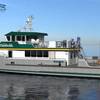Seatrade Europe, September 15-17
In the cruise industry, environmental protection is much more than a niche subject. Shipping companies, ship yards, suppliers and ports are working hard to optimize their eco-balance and consequently improve their competitiveness in terms of economics and public acceptance.
At Seatrade Europe, the conference session “Challenges for Shipping” will see industry experts discuss the challenges of combining operating costs with environmental protection. Topics will include cold ironing, emissions control, waste management and energy saving solutions.
Companies like Convotherm, specialists in energy saving combi steamers, Deerberg Systems, specialists in eco-friendly waste disposal and waste water treatment systems, and Hobart, market leader for innovative flushing technology will be exhibiting their latest developments in green technology. The LPA Group will present their newest energy efficient LED lightning systems, and the latest to confirm their exhibition space, Enwa AB from Norway, will exhibit their water treatment systems.
Due to legal regulations, increasing requirements by the shipping companies, and intensified public interest, propulsion systems have became more fuel-saving and low-emission. Podded propulsion is 25 to 50 percent more effective than conventional shaftings, with up to 15 percent lower fuel consumption. Innovations in hull design and coatings are also reducing fuel consumption; silicon or fluoropolymer applications generate sleek and low-friction surfaces, as well as being free of poisonous substances.
The German market leader, AIDA Cruises, has compiled a speed profile for each route to devise the most economic operation mode. The Rostock-based cruise operator has also set standards in waste disposal and water consumption. In 2008 the company reduced the per-capita water consumption of its ships by 12.6 percent. All new ships are equipped with vacuum food waste systems, which use significantly less water than conventional systems. All AIDA ships are additionally equipped with biological waste water treatment systems and have procedures in place to save storage on other waste materials.
Another area of improvement is in lighting, where cruise ships have the biggest energy consumption of all ships. Shipbuilder Meyer-Werft now has a partner agreement with lighting specialist Osram to develop energy saving light solutions for cruise ships. Celebrity Solstice, which was delivered in 2008, is equipped with a highly efficient light system which has decreased energy consumption by more than 15 percent. Together with a photo-voltaic system and other efficiencies around 30 percent of energy is being saved in relation to comparable ships, they claim.
Another initiative comes from the European Union which is encouraging ports to supply cruise ships with shoreside power (cold ironing). Auxiliary units can then be switched off whilst in port leading to cleaner air and less noise. A feasibility study of shoreside power for cruise ships, carried out in Hamburg, found the biggest challenge of this to be the different voltage requirements: Whilst ships operate with 60 Hz, the common frequency shoreside is 50 Hz. There seemed no doubt though, that this is the future: already cruise lines are preparing their new ships with the capacity to use shoreside power.
Seatrade Europe – Cruise, Ferry, Rivercruise & Superyacht Convention will take place from 15 to 17 September 2009 at the Hamburg Exhibition Area in hall A4. The venue is opened for trade visitors on 15 and 16 September from 10 a.m. to 6 p.m. and on 17 September from 10 a.m. to 2 p.m. Entrance is permitted for approved trade visitors only.
(www.seatrade-europe.com)













